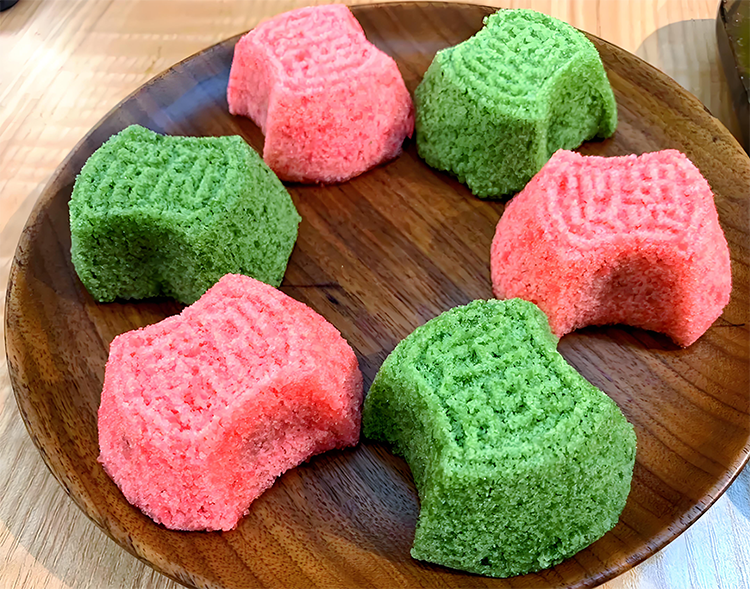Dingsheng Cake: Taste Jiangnan’s Lucky Ancient Dessert!
1. Introduction: Dingsheng Cake, Jiangnan’s Lucky Treasure
Soft and pink as flower petals, steaming warm, Dingsheng Cake melts in your mouth.
The tender rice flavor blends with sweet red bean paste.
It is more than a dessert.
It carries the ancient Jiangnan charm and Southern Song dynasty traditions.
Every bite tells a story of history, culture, and luck.
2. Origins and History
Dingsheng Cake traces back to the Southern Song dynasty.
Legend says villagers created silver-boat-shaped cakes to inspire soldiers.
Inside each cake was a note with battle strategy.
General Han Shizhong used it and won, naming it “Dingsheng Cake.”
Another story suggests villagers made it to encourage the Yue army.
The cakes bore the characters “Ding Sheng,” meaning “guaranteed victory.”

3. Cultural Significance
For locals in Nanxun, Dingsheng Cake is more than a snack.
It symbolizes blessings, luck, and success.
People gift it during births, housewarmings, school entrances, or weddings.
When daughters marry, it is often part of the dowry.
Parents hope the daughter will live peacefully and happily in her new home.
Each cake carries eight centuries of cultural wishes.
4. Ingredients: Tradition in Every Bite
Authentic Dingsheng Cake uses 70% glutinous rice and 30% regular rice.
The filling is handmade red bean paste mixed with soft pork fat.
Specially, rose jam fermented over six months is added.
Natural red yeast rice powder gives a gentle pink hue.
This combination creates a delicate, fragrant, and lucky dessert.

5. Preparation Process
Master chefs follow twelve traditional steps.
Rice is ground, sieved with a 32-mesh copper sieve, and mixed carefully.
The dough rests for a day to enhance the rice aroma.
It is pressed into century-old camphor wood molds.
Steamed over high heat for seconds, it releases a subtle sweet fragrance.
Every step carries deep craftsmanship and respect for tradition.
6. Flavor and Texture
Freshly steamed Dingsheng Cake is soft like clouds.
The red bean paste is dense, pork fat adds smoothness, and rose fragrance complements the rice aroma.
Every bite unfolds layers of Jiangnan flavors.
The texture is chewy yet tender, leaving a lingering sweetness.
It balances delicate sweetness with fragrant rice, a unique Southern China experience.

7. How to Eat
The best way is when the cake cools slightly.
Pair it with Huzhou’s traditional “Three-Cup Tea” ceremony.
Stroll on Nanxun’s cobblestone streets while holding a warm cake.
Enjoy by leaning against old wooden windows or on a rowing boat with tea.
The flavors unfold slowly, letting you savor the town’s scenery and history.
8. Where to Try
Try the historic “Ye Biqi” shop on East Street, founded in 1885.
Also, “Xiao Mao Dingsheng Cake” is popular.
A single cake costs about 2.5 RMB (~$0.35 USD).
Daily steaming starts at 4 a.m.
Catching the first batch gives the most authentic taste.

9. Tourist Tips
In English, Dingsheng Cake is called “Dingsheng Cake.”
Notice the “Ding Sheng” characters and the silver ingot shape.
For souvenirs, ask for vacuum packaging.
After refrigeration, microwaving for one minute preserves flavor.
It is a perfect edible gift from Jiangnan.
10. Easy Home Version
Mix glutinous rice flour and regular rice flour at 7:3 ratio.
Add red yeast powder and rose jam for color.
Fill with red bean paste, press in mooncake molds, and steam 15 minutes.
Not as authentic as local shops, but it captures Jiangnan flavors.

11. Final Thoughts: Taste History and Luck
Try this eight-century-old lucky dessert.
It is more than a snack—it is history in every bite.
Soft, pink, and sweet, it embodies Jiangnan’s charm.
Dingsheng Cake gives you a delicious reason to explore ancient towns.
Every bite is a journey into Chinese culture, luck, and traditional craftsmanship.


